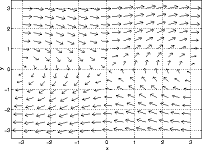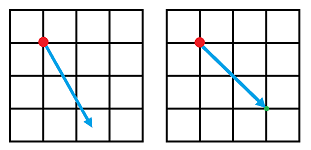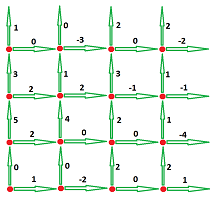This site is being phased out.
Forms vs vector fields and functions
Vector fields vs discrete 1-forms
Let's recall that a vector field is given if there is a vector attached to each point of the plane: $${\rm point} \longmapsto {\rm vector}.$$ So, vector field is just a function $$F \colon {\bf R}^2 \rightarrow {\bf R}^2.$$
For example, the following picture could be a velocity field of a flow:
Now, what is a discrete vector field?
It might be natural to assume that it should also be a function, but "discrete": $$F \colon {\bf Z}^2 \rightarrow {\bf R}^2,$$ or $$F \colon {\bf Z}^2 \rightarrow {\bf Z}^2.$$ Then the "vector field" would look for the former and the latter case like this:
In the former case, the velocity at the new location is unknown and defining it in some way (sampling or averaging) brings us back to considering a continuous vector field.
The latter is still not a good model for a flow because here the flow moves in jumps, unlike with a continuous vector field. It might be, however, a way to model particle motion, see Modelling motion with discrete forms.
We imagine that our liquid moves only along our grid which is thought of as a system of pipes:
But, with the "speed" assigned to each directed edge, this is just a discrete $1$-form!
In the picture above, the numbers represent "flows" through these "pipes", with the direction determined by the direction of the $x,y$-axes. In particular,
- the "$1$" can be understood as: "$1$ cubic foot per second from left to right".
- the "$2$" can be understood as: "$2$ cubic feet per second upward".
To confirm that this model makes sense, let's consider a $1$-form with $1$'s on all vertical and horizontal edges: $dx+dy$. The liquid is flowing up and right equally. $$ \newcommand{\ra}[1]{\!\!\!\!\!\!\!\xrightarrow{\quad#1\quad}\!\!\!\!\!} \newcommand{\da}[1]{\left\downarrow{\scriptstyle#1}\vphantom{\displaystyle\int_0^1}\right.} \newcommand{\la}[1]{\!\!\!\!\!\!\!\xleftarrow{\quad#1\quad}\!\!\!\!\!} \newcommand{\ua}[1]{\left\uparrow{\scriptstyle#1}\vphantom{\displaystyle\int_0^1}\right.} % \begin{array}{ccccccccccccccc} & & \ua{1} & & \ua{1} & & \ua{1}\\ & \ra{1} & \bullet & \ra{1} & \bullet & \ra{1} & \bullet & \ra{1}\\ & & \ua{1} & & \ua{1} & & \ua{1}\\ & \ra{1} & \bullet & \ra{-1} & \bullet & \ra{1} & \bullet & \ra{1}\\ & & \ua{1} & & \ua{1} & & \ua{1} \end{array} $$
How well does it model the flow in the diagonal direction?
Imagine, what happens if we let a drop of dye to be taken by the flow. Even though diffusion is inevitable, the predominantly diagonal direction of the spreading of the dye is evident in this Excel simulation:
Exercise. Find the formula for the diagonal elements.
Vector fields and functions vs continuous forms
A similar correspondence exists between vector fields and continuous forms is even simpler.
Let's recall the definition of a $1$-form. It's $$\varphi = A dx + B dy,$$ where $A$ and $B$ are functions. Or, more compactly, we can write $$\varphi = (A,B) \cdot (dx,dy)$$ via dot product.
So, the form $\varphi$ is completely determined by the pair of functions $(A,B)$, and vice versa. But $(A,B)$ is just a vector field!
Similarly, other differential forms have counterparts:
$$\begin{align*} 0{\rm -forms} &= {\rm functions} \\ 1{\rm -forms} &= {\rm vector \hspace{3pt} fields} \\ 2{\rm -forms} &= {\rm functions} \end{align*}$$
How does this work?
$$\begin{align*} &0: A \longleftrightarrow A, {\rm a \hspace{3pt} function}\\ &1: Adx \hspace{1pt} dy \longleftrightarrow A{\rm ,a \hspace{3pt} function} \\ &2: A dx + B dy \longleftrightarrow (A,B), {\rm a \hspace{3pt} vector \hspace{3pt} field} \\ \end{align*}$$
This is called the fundamental correspondence (FC).
What about the exterior derivative? What corresponds to it?
Consider this diagram for the fundamental correspondence the vector spaces of differential forms on the left and functions on the right:
$$ \newcommand{\lra}[1]{\!\!\!\!\!\!\!\xleftarrow{}\!\xrightarrow{\quad#1\quad}\!\!\!\!\!} \newcommand{\ra}[1]{\!\!\!\!\!\!\!\xrightarrow{\quad#1\quad}\!\!\!\!\!} \newcommand{\da}[1]{\left\downarrow{\scriptstyle#1}\vphantom{\displaystyle\int_0^1}\right.} % \begin{array}{ccccccccccc} \Omega^0 & \ra{FC} & {\rm functions} \\ \da{d_0} & & \da{ {\rm ?} } \\ \Omega^1 & \ra{FC} & {\rm vector \hspace{3pt} fields} \\ \da{d_1} & & \da{ {\rm ?} } \\ \Omega^2 & \ra{FC} & {\rm functions} \end{array} $$
The vertical arrows on the left are the exterior derivative operators (this is the De Rham complex). The fundamental correspondence operators $\lambda _0, \lambda _1,\lambda _2$ are defined above. Now, there are also some operators between the functions on the right.
Just recalling operations of vector calculus, we can suggest meanings for the arrows with "?". Specifically, such as:
- the gradient takes a scalar function to a vector function, and
- the rotation takes a vector function to a scalar function (in $R^2$, different in $R^3$):
This is the result:
$$ \newcommand{\lra}[1]{\!\!\!\!\!\!\!\xleftarrow{}\!\xrightarrow{\quad#1\quad}\!\!\!\!\!} \newcommand{\ra}[1]{\!\!\!\!\!\!\!\xrightarrow{\quad#1\quad}\!\!\!\!\!} \newcommand{\da}[1]{\left\downarrow{\scriptstyle#1}\vphantom{\displaystyle\int_0^1}\right.} % \begin{array}{cccccccccc} \Omega^0 & \ra{FC} & \{functions\} \\ \da{d_0} & & \da{ {\rm gradient} } \\ \Omega^1 & \ra{FC} & \{vector fields\} \\ \da{d_1} & & \da{ {\rm rotation} } \\ \Omega^2 & \ra{FC} & \{functions\} \end{array} $$
Of course, we would like this to be a commutative diagram, so that, in particular, following the green arrow or the red arrow would produce identical results.
Let's follow the arrows:
- Given a $0$-form $A$, we start at the top left and go down then right. We compute:
$$A \longmapsto dA = A_x dx + A_y dy \stackrel{ {\rm FC} }{\longmapsto} (A_x,A_y)={\rm grad} A.$$ So, it's the same if we go right and then down.
- Given a $1$-form $\phi = Adx + Bdy$, we start at the right middle. We compute using the formula for the exterior derivative we have found previously:
$$\phi \longmapsto d\phi = A_ydy \hspace{1pt} dx + B_x dx \hspace{1pt} dy = (B_x-A_y)dx \hspace{1pt} dy \stackrel{ {\rm FC} }{\longmapsto} {\rm rot}(A,B).$$
Again, it works out.
Let's take a look at the fundamental correspondence in dimension $3$ next.
We have a commutative diagram of vector spaces and linear operators: $$ \newcommand{\ra}[1]{\!\!\!\!\!\!\!\xrightarrow{\quad#1\quad}\!\!\!\!\!} \newcommand{\da}[1]{\left\downarrow{\scriptstyle#1}\vphantom{\displaystyle\int_0^1}\right.} \newcommand{\la}[1]{\!\!\!\!\!\!\!\xleftarrow{\quad#1\quad}\!\!\!\!\!} \newcommand{\ua}[1]{\left\uparrow{\scriptstyle#1}\vphantom{\displaystyle\int_0^1}\right.} % \begin{array}{ccccccccccc} & \Omega ^0 & \ra{FC} & \{functions\} & f\longmapsto f \\ & \da{d_0} & & \da{grad} \\ & \Omega ^1 & \ra{FC} & \{vector fields\} & Adx+Bdy+Cdz \longmapsto (A,B,C)\\ & \da{d_1} & & \da{curl} \\ & \Omega ^2 & \ra{FC} & \{vector fields\} & Pdxdy+Qdydxz+Rdzdx \longmapsto (Q,R,P)\\ & \da{d_2} & & \da{div} \\ & \Omega ^3 & \ra{FC} & \{functions\} & Adxdydz \longmapsto A\\ \end{array} $$ The horizontal arrows, that stand for the fundamental correspondence, are clearly isomorphisms. This means that the linear algebra of exterior calculus and that of vector calculus are identical!
However, let's compare the columns, in terms of the quality of the mathematics.
| Left column | Right column | |
| Objects: | differential forms with a clear hierarchy | functions and vector fields appear twice each |
| Operators: | exterior derivative with a uniform meaning | $grad,curl,div$ seem to have nothing to do with each other |
| Generality: | all dimensions | limited to 3 dimensions |





